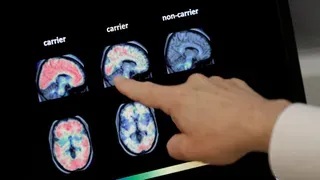December 15, 2024
Are Trans Women 'Biologically Male'? The Answer is Complicated
READ TIME: 8 MIN.
A History of Changing Sex
In the modern era, the scientific concept of transgender – that there could be a perceived or felt difference between one's psychological sex and their biological sex – dates back to at least the late 19th century. At that time, the very definition of sex itself was changing.
For centuries prior, sex was commonly determined through a simple visual inspection of anatomy: does a person have a penis or a vulva?
By the 1870s, however, scientific advancements in dissection and the study of intersex conditions led some researchers to posit a new definition of biological sex: one based on gonads – internal reproductive anatomy such as testes or ovaries – rather than external genitalia.
Herculine Barbin is an example of this shift. Assigned female at birth, Barbin was raised in 19th-century France as a girl. In her teenage years, a doctor discovered hidden testicles adjacent to her vaginal canal. Based on this internal anatomy, a court ruled Barbin's sex must be reassigned to male. Her "true sex," the court resolved, was gonadal.
As transgender medicine emerged as a field of study in the 1920s and 1930s, the gonadal view of sex reigned. Eugen Steinach, an Austrian scientist, conducted studies demonstrating that a guinea pig's sex could be changed by removing its gonads and replacing them with the gonads of the opposite sex.
Transgender advocates such as the German physician Magnus Hirschfeld realized that human sex functioned in a similar way to Steinach's guinea pigs. If the hormonally induced characteristics many people consider "male" and "female" – such as facial hair, breast growth or the pitch of one's voice – are largely determined by gonads, then a person can change their sex by changing gonads. Therefore, the most common surgeries for trans women at this time consisted of orchiectomies – the removal of testes.

The Sexual Revolution
By the 1960s and 1970s – the era of second-wave feminism and the sexual revolution – the debate over biological sex was as unclear as ever.
In competitive athletics, there was a shift away from genital inspections to the Barr body test, which determines sex based on chromosomes. But at the same time, with advancements in plastic surgery, leading clinicians in transgender medicine believed they were able to change a trans woman's sex by transforming her penis into a vagina.
As an example of this era's complexity, when Renee Richards, a transgender women's tennis player, was forced to take a chromosomal test to qualify for the 1976 U.S. Open, she challenged the policy as discriminatory. The New York State Supreme Court agreed, with the judge declaring that there is "overwhelming medical evidence that (Richards) is now female."
How had Richards changed sex? The answer, she said, was gynecological. "Have a gynecologist examine" me, she proposed in a 1976 television interview, "and then you'll have your answer, 'Is this person a man or a woman?'"
By the late 1970s, definitions of biological sex were so contested that even Janice Raymond, the 20th century's most influential anti-transgender theorist, affirmed that scientists understood there to be at least six different types of sex: chromosomal, anatomical, gonadal, hormonal, legal and psychological.
For Raymond, a committed lesbian feminist who believed that even transgender women without testes or penises were still a threat to women-only spaces, it was ultimately their socialization as boys and as young men, she reasoned, that made transgender women "male" – not a biological argument at all.

Bathroom Panic
In response to Mace's bill, U.S. Rep. Alexandria Ocasio-Cortez of New York asked whether women will have to "drop trou" and let a government agent "inspect her genitals" in order to use the Capitol's restrooms.
Her comment was meant to be provocative, but there is no way for the House sergeant-at-arms to enforce a rule on biological sex when there is no commonly understood definition of that term.
Which brings us back to McBride.
In public comments, Mace claims she wants to keep "junk" (genitals) and "balls" (gonads) out of women's restrooms. Of course, many transgender women do not possess these characteristics. If, for Nancy Mace, genitals and gonads make someone "biologically male," then not all transgender women are the threat to women's "safety and dignity" that she fears.
But Mace's Republican colleagues are pushing a stricter definition of sex. Some legislators want to rewrite federal law to declare that sex is the "body structures (phenotypes) that, in normal development, correspond to one or the other gamete – sperm for males and ova for females."
If that sentence seems strange, perhaps it is because the majority of Americans understand that "male" and "female" are defined by "sex assigned at birth," which commonly occurs through genital inspection – not based on one's hidden internal ability to produce eggs or sperm.
So why are Republicans seeking to rewrite "sex" in federal law to refer to gamete production, rather than maintain familiar notions of sex that have endured for centuries, such as genitals or gonads?
For once, the answer isn't complicated: The gamete definition of "sex" will ensure that transgender women are always classified as "male" no matter how much they change their bodies. Federal bills defining sex do this by declaring that a woman is someone "who naturally has, had, will have, or would have" the reproductive capacity to produce eggs – something a transgender woman can never do.
But what do sperm and ova have to do with using the bathroom?
For most of modern history, scientists, doctors and judges have agreed that humans can change sex – they just haven't agreed on how it can be accomplished. To change the definition now is to invite heightened government scrutiny into the private medical records of all women. It remains to be seen whether most Americans will agree with this new definition.![]()
G. Samantha Rosenthal, Visiting Assistant Professor of American History, Washington and Lee University
This article is republished from The Conversation under a Creative Commons license. Read the original article.







